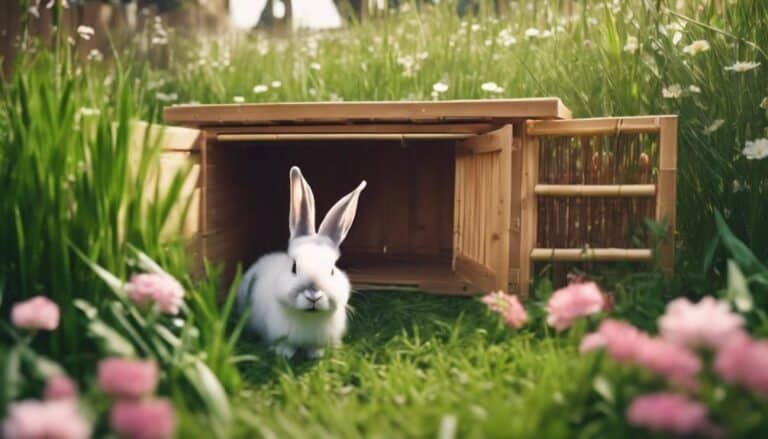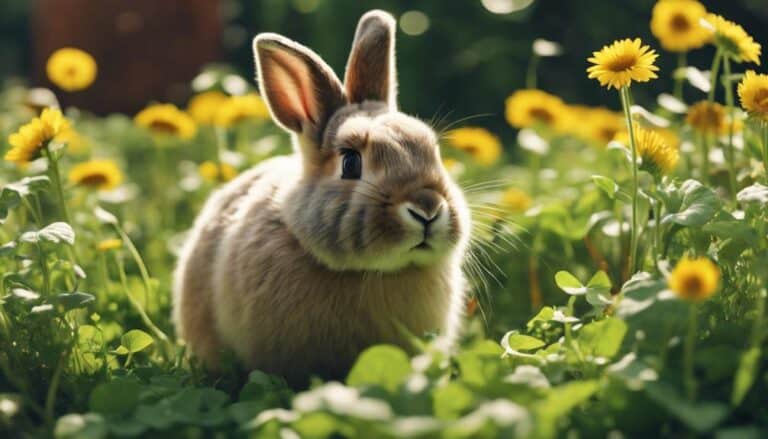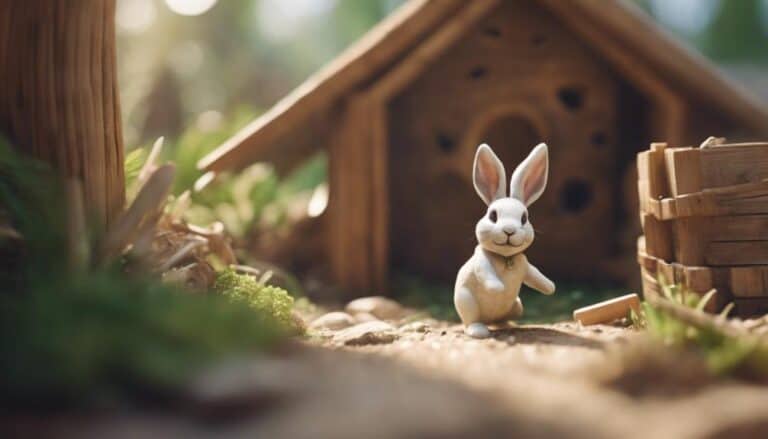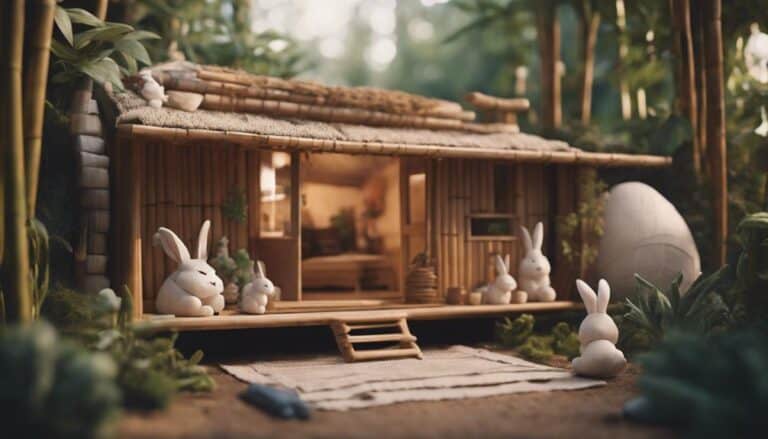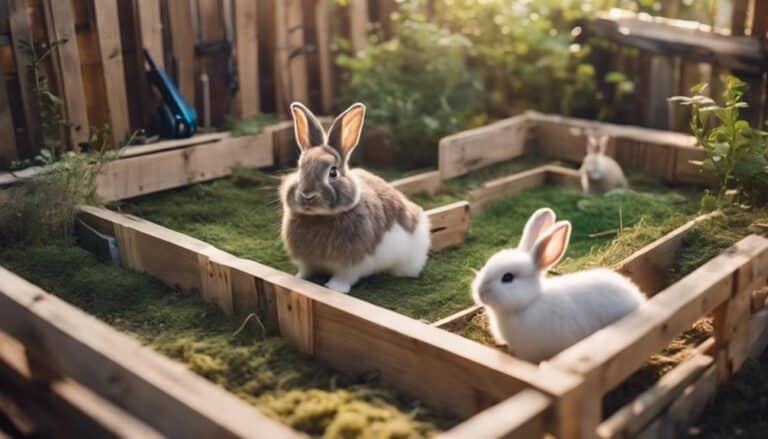Did you know that providing your bunny with a variety of hiding spots can greatly reduce their stress levels?
By incorporating these natural instincts into their habitat, you can create a safe and stimulating environment for your furry friend.
Discover how these simple yet effective tips can enhance your bunny's well-being and happiness, ensuring they lead a fulfilling and content life.
Contents
- 1 Key Takeaways
- 2 Habitat Size and Layout
- 3 Bedding and Resting Areas
- 4 Exercise and Enrichment Spaces
- 5 Predator Protection and Safety Measures
- 6 Temperature Regulation and Ventilation
- 7 Hygiene and Cleaning Practices
- 8 Frequently Asked Questions
- 9 How Can I Enhance My Bunny’s Habitat to Ensure Its Safety?
- 10 Conclusion
Key Takeaways
- Provide a spacious living area with engaging exercise spaces.
- Ensure cozy bedding and separate resting areas for hygiene.
- Offer a variety of toys and enrichment activities for mental stimulation.
- Design a play area with tunnels, hiding spots, and interactive toys for physical and mental well-being.
Habitat Size and Layout
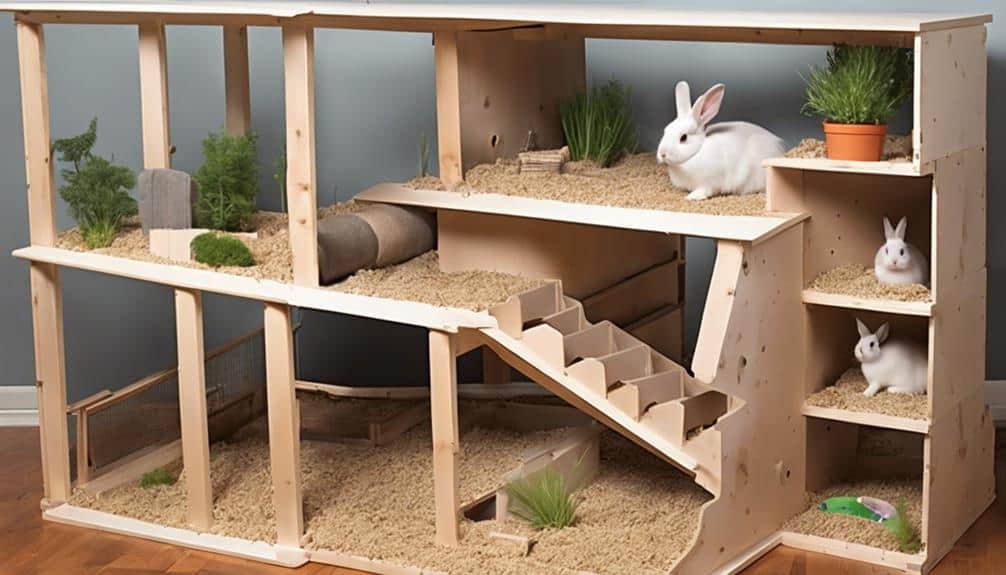
For best rabbit well-being, prioritize spaciousness and thoughtful design in their habitat. Rabbits thrive in environments that allow them to exhibit their natural behaviors. When it comes to habitat size, providing ample living space is essential. A minimum of 10ft x 6ft x 3ft for a pair of rabbits guarantees they've room to run, jump, and stretch, promoting their physical and mental health.
Make sure your rabbits have access to a spacious shelter within their habitat. This shelter should be large, sturdy, waterproof, and raised off the ground to protect them from the elements and predators. Additionally, a well-designed exercise area that's important, engaging, and accessible to your rabbits is key. This area should encourage physical activity and play, keeping your rabbits happy and stimulated.
When setting up outdoor enclosures for your rabbits, make sure to provide the essentials such as water, hay, shade, and companionship. Remember, the more space your rabbits have in their habitat, the happier and healthier they'll be. Prioritizing spaciousness and thoughtful design in your rabbits' living space is key to their well-being.
Bedding and Resting Areas
When creating bedding and resting areas for your rabbits, prioritize their comfort and health by using soft straw or newspaper for insulation and comfort. Here are some key tips to enhance your bunny's habitat:
- Separate Sleeping and Eating Areas: Provide distinct compartments for sleeping and eating/relaxing to establish a hygienic resting space for your rabbit. This separation helps in maintaining cleanliness and reduces the risk of contamination.
- Avoid Harmful Bedding: Refrain from using wood shavings as bedding, as they can pose a threat to your rabbit's respiratory system. Opt for safer alternatives like soft straw or newspaper to make certain your rabbit's well-being.
- Maintain Proper Ventilation: Create well-ventilated and draught-free resting areas for your rabbit to support their overall health. Adequate airflow helps in regulating temperature and preventing the buildup of harmful fumes or bacteria.
Exercise and Enrichment Spaces
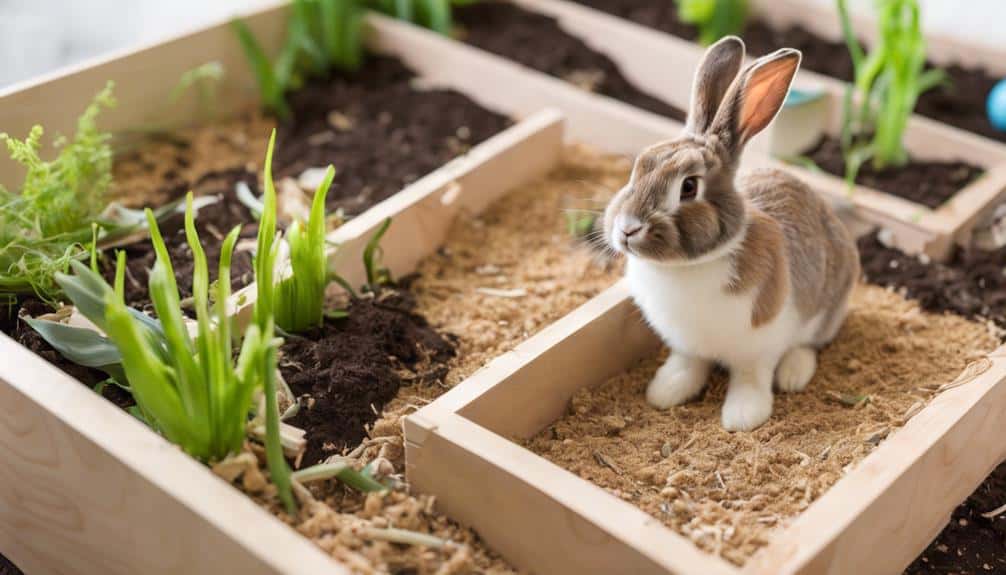
To guarantee your rabbit's well-being, offer ample exercise time outside the enclosure daily, incorporating hiding spots, tunnels, ramps, and platforms to stimulate natural behaviors.
Introduce a variety of engaging toys like tunnels, balls, chew toys, and puzzle feeders to keep your rabbit active and curious.
Remember to rotate toys regularly to prevent boredom and encourage your rabbit's agility and mental sharpness.
Play Area Design
Enhance your bunny's play area by creating a space that allows for ample exercise, exploration, and mental stimulation. To design the perfect play area for your pet, follow these tips:
- Utilize Tunnels and Boxes: Incorporate tunnels and boxes in the play area to encourage your bunny to explore, hide, and play.
- Include Various Toys: Provide a variety of toys such as balls, chew toys, and puzzles to keep your bunny engaged and entertained while promoting physical activity.
- Add Hiding Spots: Incorporate hiding spots and tunnels to create a sense of security for your bunny, allowing them to feel safe while playing and exploring.
Toys for Stimulation
For peak stimulation in your bunny's exercise and enrichment spaces, choose toys that encourage physical activity and mental engagement. Toys such as tunnels, balls, and puzzle feeders provide mental stimulation while promoting exercise. Incorporating chew toys made of safe materials like wood or hay not only helps maintain your bunny's dental health but also offers entertainment.
Interactive toys like treat-dispensing balls and foraging mats tap into your bunny's natural instincts, keeping them active and engaged. Climbing structures, ramps, and platforms create a dynamic environment for exploration, aiding in physical fitness. Remember to rotate toys regularly to prevent boredom and make certain your bunny stays interested in their habitat.
Predator Protection and Safety Measures
When safeguarding your bunnies from potential threats, constructing a sturdy fence using predator-resistant materials is essential.
Additionally, incorporating nighttime shelter precautions such as motion-sensor lights can help deter nocturnal predators.
Remember to regularly inspect the habitat for any vulnerabilities that could compromise your rabbits' safety.
Secure Fencing Solutions
To fortify your rabbit habitat against potential threats, sturdy fencing solutions are essential for safeguarding your furry companions from predators. Here are some key considerations to enhance the security of your rabbit enclosure:
- Opt for fencing with small gaps or buried wire to prevent burrowing predators from accessing the rabbit enclosure.
- Consider adding a protective roof or cover to prevent predators from attacking your rabbits from above.
- Regularly inspect and maintain the fencing to guarantee its integrity and effectiveness in keeping your rabbits safe.
Nighttime Shelter Precautions
To safeguard the safety and protection of your rabbits during the night, fortify the shelter with predator-proof fencing and secure locks on all entry points. Predators like foxes, raccoons, and birds of prey can pose a threat to your bunnies, so it's important to create a secure living area.
Make sure there are safe hiding places and escape routes within the nighttime shelter for your rabbits to seek refuge if needed. Consider installing motion-activated lights to deter nocturnal predators from approaching. Additionally, using underground wire mesh or hardware cloth can prevent burrowing predators from gaining access to the shelter.
Temperature Regulation and Ventilation
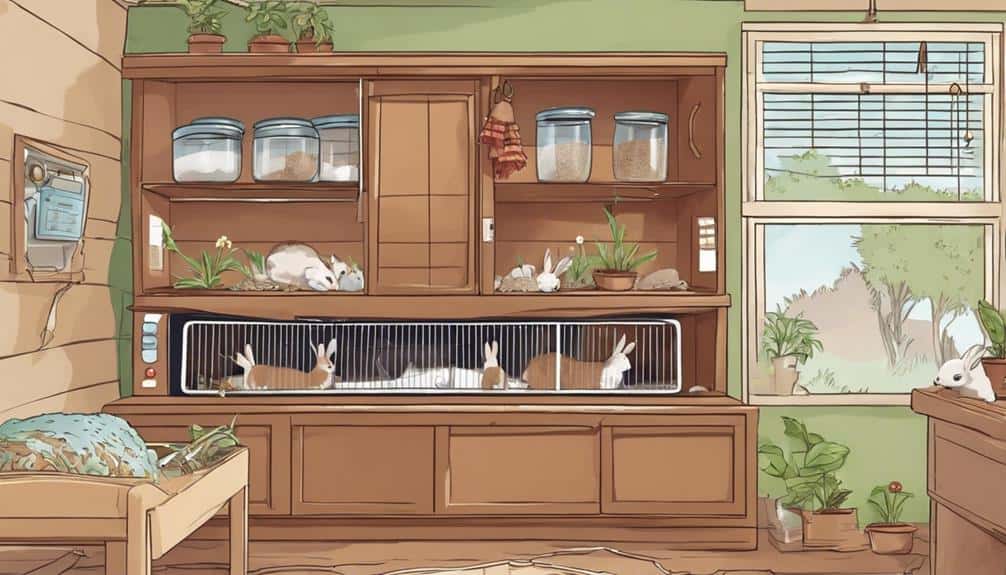
For best comfort and health of your rabbit, maintaining a habitat temperature between 60-70°F is essential. Here are some tips to make sure your bunny's habitat is well regulated and ventilated:
- Maintain a Comfortable Environment: Keep your rabbit's living space within the recommended temperature range to prevent any heat or cold-related stress on your pet.
- Guarantee Proper Ventilation: Good airflow is important to prevent humidity buildup and maintain a fresh environment for your rabbit. Avoid placing the habitat in areas with poor ventilation.
- Monitor Air Circulation: Place a thermometer in the habitat to monitor the temperature regularly. This will help you adjust as needed and ensure your rabbit is always in a comfortable environment.
Hygiene and Cleaning Practices
Maintain your rabbit's habitat remains clean and hygienic by following these effective cleaning practices. Clean the living area daily, removing waste and uneaten food to uphold a fresh environment. Utilize newspaper or shredded paper for a specific toilet area, aiding in cleanliness. Promptly replace wet bedding to guarantee odors and guarantee the rabbit's comfort.
Implement a weekly deep cleaning using pet-safe cleaners to thoroughly sanitize the habitat. Safely dispose of any hazardous substances that could pose a risk to your rabbit, creating a hazard-free living space. By maintaining clean bedding, a designated litter tray, and providing fresh water, you contribute to a hygienic environment that promotes your bunny's well-being.
Frequently Asked Questions
How Do You Make a Good Rabbit Habitat?
To make a good rabbit habitat, create a spacious living area with shelter, exercise space, and companionship. Include hiding spots, chew toys, and a tunnel system for mental stimulation. Provide comfortable bedding, food bowls, water dispensers, and a litter box.
What Does a Bunny Habitat Need?
For a bunny habitat, you need a well-rounded space. Include a play area, hideaway spot, chew toys, litter box, bedding options, feeding station, water source, grooming tools, and exercise opportunities. These elements guarantee your bunny's happiness and well-being.
What Are 4 Things Rabbits Need to Survive?
To survive, rabbits need a safe shelter, proper diet, fresh water, and regular exercise. Make sure your bunny has a secure habitat, nutritious food, clean water, and opportunities to stay active for a healthy and happy life.
What Is the Best Habitat for a Pet Bunny?
For your pet bunny's best habitat, prioritize a spacious area allowing hopping, secure hiding spots, soft flooring like natural fiber rugs, and various furniture for resting. Double-entry huts are crucial for security. Your bunny will thrive!
How Can I Enhance My Bunny’s Habitat to Ensure Its Safety?
Looking to create a safe bunny habitat setup? Start by providing a spacious enclosure with plenty of ventilation. Add hiding spots and soft bedding for comfort, and ensure they have access to fresh water and a balanced diet. Want more tips? Check out our safe bunny habitat setup FAQs for expert advice.
Conclusion
As you enhance your bunny's habitat with these tips, remember that a happy rabbit is a healthy rabbit. By providing a comfortable and enriching environment, you aren't just meeting their physical needs but also their emotional well-being.
So, whether it's creating fun hiding places or ensuring safe positioning, every little detail counts in keeping your furry friend content and thriving.
Keep up the good work and watch your bunny flourish in their new and improved home!

